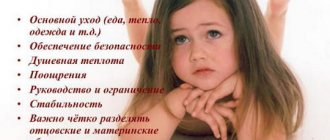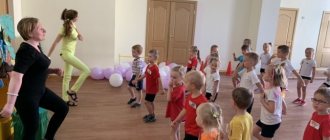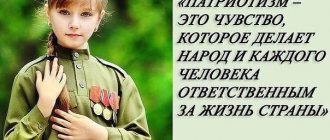Weekend route" as a way of effective interaction between family and preschool educational institution project on the topic
Parent education
“Weekend route” as a way to effectively
interaction between family and preschool educational institution.
Topic: “Walk with interest” - Museum of Moscow with a new interactive program for children of senior preschool age “Once upon a time there were Muscovites.”
Compiled and prepared by: senior teacher Deeva T.S.
“Weekend route” as a way of effective interaction between family and preschool educational institution. One of the priority areas of the preschool educational institution’s work is interaction with parents. Preschool teachers are searching for innovative forms and methods of working with parents of pupils to establish positive interaction and cooperation within the framework of the education of preschool children. One effective way to work is to develop “weekend routes”. A “weekend route” can be developed for children of all ages. The age of the child determines the specifics of the route.
The purpose of developing a “weekend route”:
Cultivating in preschoolers respect and interest in their native land, human spiritual culture through the interaction and cooperation of teachers with parents.
Route development algorithm:
— Collecting information about the place of visit, the upcoming cultural event in the life of the city via the Internet, telephone communication, personal visit.
— Collection of information about the necessary equipment and visiting conditions.
— Development of a route indicating the main attractions that should be focused on by the child. Compiling a newsletter for parents.
— Presentation of the newsletter for parents and children.
Getting feedback:
— Organizing a morning meeting in the group on Monday, sharing impressions, showing children programs, photographs, booklets from the place of visit.
— Listening to children’s mini-messages about the place of visit based on the model.
— Registration of the results of the visit in the form of photo reports, exhibitions, presentations.
Result:
Motivating parents for upcoming joint activities and further cooperation with the kindergarten. Expanding children's ideas about their hometown and region. Expansion of children's active and passive vocabulary, development of coherent speech. Saturation of the subject-spatial environment with local history materials: albums, photo exhibitions, vernissages of drawings created by children together with their parents, presentations about the city and the region.
An example of a “weekend route” for senior and preparatory groups of preschool educational institutions, as well as for “family kindergartens”:
Dear moms and dads!
The happiest day is a day off when the whole family gets together! The weekend is already a holiday.
And a weekend spent with children is a double holiday!
And to make this holiday bright and unforgettable, we bring to your attention the “Weekend Route”
on the topic: “Walk with interest.”
The Museum of Moscow with a new interactive program for children of senior preschool age “Once upon a time there were Muscovites.”
The museum is open from 10.00 to 20.00, closed on Monday, every third Sunday of the month - admission is free;
The Museum of Moscow is located at: Zubovsky Boulevard, building 2;
nearest metro station "Park Kultury";
Phone:+7.
The Museum of Moscow has launched a new series of interactive programs, including the program “Once upon a time there were Muscovites.” The interactive program “Once upon a time there were Muscovites” is taking place at the exhibition “History of Moscow for Children and Adults.”
Program participants will visit a Moscow house of the 16th century. They will learn how the house was built, what parts it consisted of, how the rooms were used, and what furniture was in them. Sitting at a large table in the red corner, the children will learn how to follow the rules of a medieval meal and how to use cutlery. They will learn how responsibilities were distributed among family members, and test their strength and dexterity by performing household chores of medieval Muscovites.
The children will be told about the “magic” of the most ordinary household items. After all, a medieval housewife could use a sieve to make it rain, and use a broom to cast out evil spirits. Program participants will also learn to play ancient games. The children will be able to travel back in time with clothes made from medieval costumes and headdresses of medieval Muscovites.
The program is designed for preschool children (4–6 years old).
We wish you a pleasant cultural holiday!
Photo “Weekend route” Museum of Moscow, November 2021
“Weekend route” as a way of effective interaction between family and preschool educational institution.”
Topic: “Walk with interest” - Museum of Moscow with a new interactive program for children of senior preschool age “Once upon a time there were Muscovites.”
Compiled and prepared by: senior teacher Deeva T.S.
Progress of the event:
One of the priority areas of the preschool educational institution’s work is interaction with the families of pupils. Preschool teachers are searching for innovative forms and methods of working with families to establish positive interaction and cooperation within the framework of the education of preschool children. A modern kindergarten should become a child-parent center in which every family will find help and support in raising children.
Children should not only gain knowledge about their city, but also actively participate in acquiring this knowledge together with their parents.
The goal of developing “weekend routes” is to instill in preschoolers respect and interest in their native land through the interaction and cooperation of teachers with families. The goal can be achieved through solving the following tasks:
- generalize and systematize knowledge about the native land,
- expand children's horizons,
— form ideas about the sights of the city of Moscow;
- introduce children to the geographical location of the city,
— to cultivate love and a sense of pride for the city in which we live.
It is important to be able to present the material clearly and intelligibly. It depends on whether the child will accept the knowledge received and whether he will have a desire to learn something new. In older preschool age, the amount of knowledge about one’s hometown increases. We introduce children to the history of the city of Moscow and its sights and famous people.
Progress of the event:
1) Choosing a “Weekend Route” with the aim of instilling in preschoolers respect and interest in their native land, a person’s spiritual culture through the interaction and cooperation of teachers with parents.
2) Route development algorithm:
— Collecting information about the place of visit, the upcoming cultural event in the life of the city via the Internet, telephone communication, personal visit.
— Collection of information about the necessary equipment and visiting conditions.
— Development of a route indicating the main attractions that should be focused on by the child. Compiling a newsletter for parents.
— Presentation of the newsletter for parents and children.
3) Receiving feedback from parents and children:
— Organizing a morning meeting in the group on Monday, sharing impressions, showing children programs, photographs, booklets from the place of visit.
— Listening to children’s mini-messages about the place of visit based on the model.
— Registration of the results of the visit in the form of photo reports, exhibitions, presentations.
4) Result:
Motivating parents for upcoming joint activities and further cooperation with the kindergarten. Expanding children's ideas about their hometown and region. Expansion of children's active and passive vocabulary, development of coherent speech. Saturation of the subject-spatial environment with local history materials: albums, photo exhibitions, vernissages of drawings created by children together with their parents, presentations about the city and the region.
Methods and techniques used in adult activation activities:
Observation, as a method of studying family, is characterized by purposefulness. In this case, the teacher determines in advance for what purpose, when, and in what situation the parents and their interaction with the child will be observed. When exchanging impressions, the teacher is struck by many features of the relationship between an adult and a child, by which one can judge the degree of their emotional attachment and culture of communication. Based on what parents and children talked about, what emotions were shown by the child and parents who took part in the joint event, one can draw a conclusion about the priorities of modern education and the attitude towards the preschool institution.
During the conversation, they feel that the teacher has no other goal than to provide assistance. This helps to increase confidence and improve the pedagogical effectiveness of the conversation. The teacher should be able to emphasize the positive aspects of such interaction and create a certain “pedagogical hope” for future interaction.
The questionnaire method (mini-survey) allows you to collect data that interests the teacher. This method is characterized by a certain flexibility in the possibility of obtaining and processing the resulting material. In family study work, contact surveying is used, i.e. (the teacher himself organizes the survey and collects questionnaires), which gives parents a sense of trust, supports the desire to continue communication, parents feel that their opinions and interests are taken into account by the teacher for planning further collaboration.
Used Books:
- Abdullina, L.E. “Conceptual ideas of an approximate basic general education program for preschool education, “World of Discovery” (from birth to 7 years) / L.E. Abdullina: Academy, 2011 - 65 p.
- Aleshina, N.V. “Familiarization of preschoolers with the environment and social reality.” / N.V. Aleshina. M.: Elise Trading, 2004 – 246 p.
- Buchilova, I.A. “The problem of diagnostics and correction of child-parent relationships in families // Modern scientific research.” Concept, 2013
- Makhaneva, M.D. “Moral and patriotic education of preschool children / M.D. Makhaneva // Management of a preschool institution,” 2005 - 55-67 p.
- Doshkolenok.ru is a website for kindergarten teachers. https://dohcolonoc.ru/
Get into the Russian spirit
Where: Kostroma, 320 km from Moscow
Kostroma is the farthest city of the Golden Ring from Moscow, small and provincially cozy. The best thing is to escape for the weekend and enjoy simple pleasures for two or three days. Start the promenade from the embankment, which puts even the most tired people into “relaxation” mode. Stroll to pleasant Central Park and marvel at Ilyich on the pedestal for the 300th anniversary of the House of Romanov. Kostroma residents like to talk about Ostrovsky’s gazebo, as if Katerina from “The Thunderstorm” jumped into the water from there. The story is gloomy, but the view of the Volga is excellent.
To feel the merchant spirit of Kostroma, walk through the galleries of the shopping arcades. In the Big Flour Rows there is a Cheese Exchange, where, in addition to the usual Gouda and Maasdam, you can try local Camembert, Brie and Parmesan. On Susaninskaya Square, popularly called Frying Pan, look for a bronze basset hound and take a classic photo with a tower. By bus or minibus, get to the Ipatiev Monastery, within whose walls the history of the last dynasty of monarchs in Russia began in 1613. And next door, look at the wooden houses, churches and barns collected in the open-air museum “Kostromskaya Sloboda”.
Drive out of town in your car or taxi to a moose farm. There you will feed the elk with carrots, and from May to September you will also try elk milk. Then go deeper into the Kostroma forests to unexpectedly emerge at the Ostrovsky house-museum. You can stay there, in the Shchelykovo sanatorium, or in one of the hotels in Kostroma itself.
Don’t delay your trip: What to see in other cities of the Golden Ring of Russia Visiting the Snow Maiden in Kostroma and other ways to have a great winter vacation in Russia
Play with contrasts
Where: Kazan
Go to Kazan for exotic things. In this city, Russian and Tatar cultures are curiously intertwined, and surprises await you at every turn. Inside the Kremlin, visit the Orthodox cathedral and mosque, which stand two steps away from each other. At the Museum of Islamic Culture, find out how and when the Tatars became Muslims and take part in a master class on Arabic calligraphy. To the side of the center, you will be surprised by the colorful Ecumenical Temple, the domes of which are decorated in the traditions of different religions, from Judaism to Buddhism. Take a walk along Kazan Arbat - Bauman Street, look at the old mansions and listen to the performances of street musicians.
A separate and very significant reason to fall in love with Kazan is the local cuisine. For teleportation to gastronomic paradise, Tatar pastries are enough: from triangular pies to echpochmaks
to the multi-layer pie
Gubadiya
- everything is so tasty that you involuntarily reach for more.
Pull yourself together and leave room for horse meat sausage, tokmach noodle soup ,
beshbarmak
with
various meats and Tatar pilaf. Walk into a Tatar restaurant if you're really hungry: after just one dish, you still won't stop.
More ideas: 12 things to do in Kazan Unexpected dishes from all over Russia
Cheap tickets to Kazan
Best hotels in Kazan





